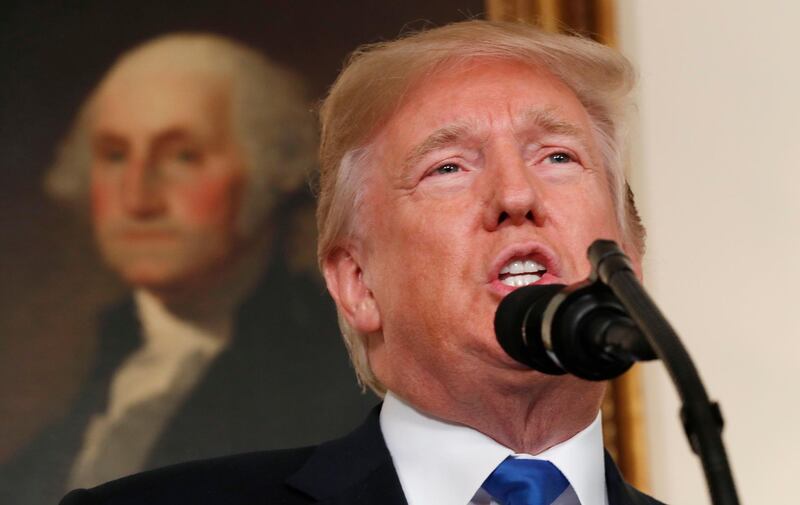US president Donald Trump has made clear his support for the Iran protests, sending out seven tweets in six days and seizing the opportunity to highlight his longstanding criticism against the Tehran regime.
But beyond the Twitter campaign and public outcry in Washington, the US administration has begun examining how best to support the protesters. In an interview with Voice of America, the deputy assistant secretary of state for Iraq and Iran, Andrew Peek, said the White House is exploring how to respond to the crackdown on demonstrators and consulting at a high level with international partners on how to coordinate that response.
“From our part, we will hold accountable those people or entities who are committing violence, from the top to the bottom, against the protesters," Mr Peek said. "That involves examining actions we can take against those individuals, like sanctions and other means.”
Michael Singh, a senior fellow at the Washington Institute for Near East Policy who studies Iran, told The National that the protests only underscore Mr Trump’s criticism of the Iranian regime, which he on Tuesday described as “brutal and corrupt."
That Mr Trump should side with the protesters against a regime he has long criticised is no surprise, Mr Singh said. But his administration also wants to ensure it responds in a very different way from the cautious approach taken by Mr Trump's predecessor, Barack Obama, in 2009 when the demonstrators were again out on the streets of Tehran.
However, Ali Vaez, director of the Iran Project at the International Crisis Group, says there are important distinctions to be drawn between the two waves of protests.
“Unlike the 2009 uprising these protests have no discernible leader, organization, and objective; the slogans range from economic demands to regime change. The protests are more scattered... and the government's initial response has been less violent than in 2009,” he told The National. But, he warned, "The longer they persist, the likelier that the security forces will bring down their iron fist.”
If that were to happen, Washington could respond with stronger sanctions targeting either individuals involved in the crackdown, or companies inside and outside Iran involved in supplying tools and technology for the clamp down.
“There is no doubt that whatever plans the administration and Congress had for Iran, they are being reconsidered in light of these events,” Mr Singh said.
_______________
Iran protests
A voice from Tehran: Iran's leaderless protests hindered as communication links are shut down
[ Iran protests point to a genuine desire for counter-revolution ]
_______________
The protests come as another decision looms for the Trump administration on January 15 on the fate of the Iran nuclear deal. In October, President Trump gave Congress and America’s European partners three months in which to strengthen provisions in the Joint Comprehensive Plan of Action (JCPOA), before deciding whether he would sign the waiver that would continue the freeze on US sanctions.
If those provisions are not in place, the sanctions could be reactivated and eventually the deal - which is meant to limit Iran's nuclear productivity - could be ditched altogether.
And if the crackdown on the protests turns more violent, President Trump could use that to justify either imposing more sanctions or walking away from the deal, said Mr Vaez.
Yet even as Mr Trump continues to lambast the JCPOA, and to fume about how “all the money that President Obama so foolishly gave them [the Iranian regime] went into terrorism," experts such as Mark Dubowitz, the chief executive at the Foundation for Defence of Democracies, believe the president will keep the nuclear deal separate from his views about the protests.
“The protests are unlikely to change the president’s waiver decision. That decision is driven by his assessment of whether or not Congress and the Europeans have responded to his October 13 speech in which he called for a bipartisan and transatlantic fix to the nuclear deal or he would nix it,” Mr Dubowitz told The National. "Instead I could see the protests becoming a possible incentive for all sides [the EU, Congress, the White House] to come together and find a legislative solution.”
There could also be a danger in shifting focus away from the demonstrations to the JCPOA or sanctions, said Mr Singh. "The regime [in Iran]may garner more international sympathy,”
Mr Dubowitz agrees that staying fixed on the protests was the right policy for the Trump team. “It reinforces the administration’s view that the Iranian regime is an odious, expansionist and destructive force in the Middle East,” he said.







